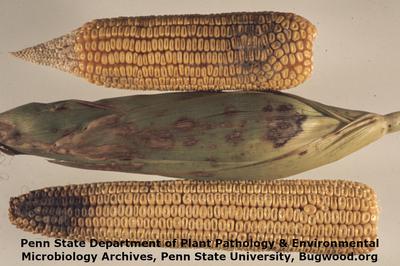Late Wilt of Maize
Magnaporthiopsis maydis
Fungus
In a Nutshell
- Usually occurs during or after flowering stage.
- Plant start to wilt from the bottom up.
- Leaves have a dull green appearance first and later wither.
- Lower internodes are discolored, turn reddish brown and soft, and eventually become hollow and dry.
Can also be found in
Symptoms
Symptoms are usually observed during or after the flowering stage and vary in intensity depending on the variety of maize and weather conditions. Leaves in the lower part of the plants start to wilt and turn dull green. Gradually, they become dry and start to roll inwards, while the symptoms progress upward. Ears of affected plants do not grow properly, husks may have lesions and grains development is impaired. In some cases, yellowish to purple or dark brown streaks are visible at the base of the stalks. Part of the vascular tissue and the internodes turn reddish-brown, something that is clearly visible in a cross-section of the stalk. Eventually they become dry, shrunken, and hollow.
Recommendations

Organic Control
Several solutions based on microorganisms have been tested in laboratories to treat seeds and/or reduce the incidence of this pathogen: the fungi Trichurus spiralis, Streptomyces graminofaciens, S. gibsonii, S. lydicus, S. nogalater, S. rochei, S. annulatus and the yeasts Candida maltosa, C. glabrata, C. slooffii, Rodotorula rubra and Trichosporon cutaneum. Solutions containing the antagonistic bacterium Bacillus subtilis also reduce infections when added to infested soil at the time of sowing.

Chemical Control
Always consider an integrated approach with preventive measures together with biological control measures if available. As it is a soil and seedborne disease, it is recommended to purchase seeds from a certified source. Seed treatment with a water bath of fungicide may also work. Products based on azoxystrobin or captan or combinations of fungicides are effective against the fungus.
What caused it?
The symptoms are caused by Magnaporthiopsis maydis, a fungus that overwinters in the soil and potentially also on seeds. The soil- or seedborne spores infect the roots of seedlings via small wounds and gradually colonize the tissues as they develop. In the vessels, they are translocated from the roots up the stalk and into the ear and grains. Optimal conditions for disease development are: constant temperature around 24 °C or natural temperature variations between 20 and 32 °C. Higher temperatures inhibit the growth of the fungus and less occurrence is observed at 36 °C, for example. This disease is economically important in several parts of the world.
Preventive Measures
- Choose resistant varieties, if available.
- Purchase seeds from a certified source.
- Test seeds for the presence of the fungus before planting.
- Plan a good irrigation plan to avoid too much moisture in the soil.
- Do not use or sow seeds from infected area.
- Plan a good fertilization during the season, mainly in terms of potash applications.
- Plan a crop rotation with rice or other non-susceptible plants over several years.



